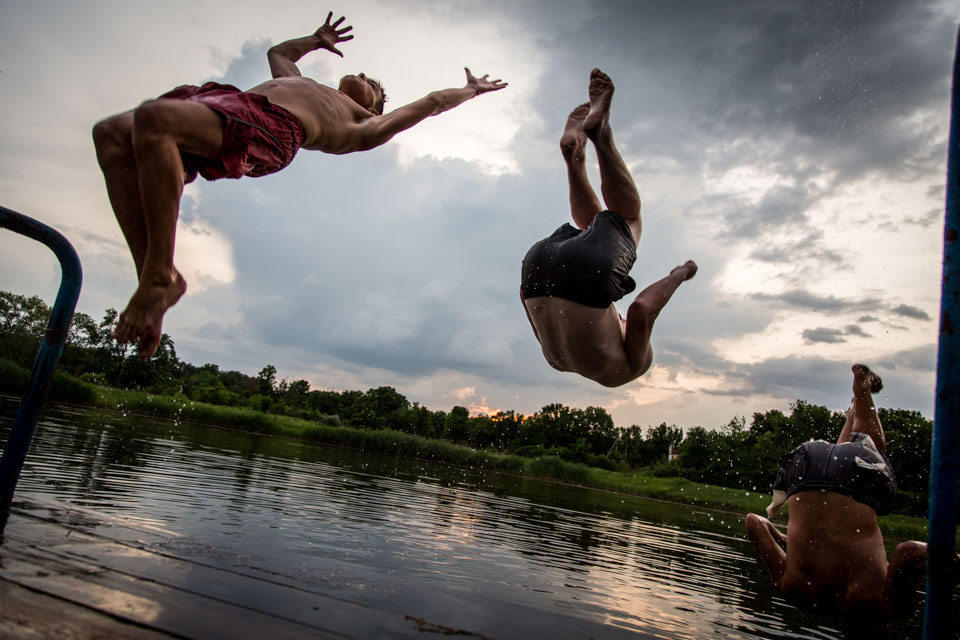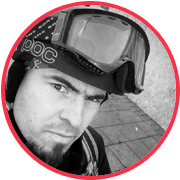
A Year Under Shelling: The Life of Civil Donbass

Dania (on the left) and his friends are flipping from the pier of the Vosmyorka (“Eight”) lake in central Luhansk. Dania is 17, and an hour ago the shop assistant in a local shop refused to sell him a bottle of vodka. Despite being young, Dania serves in the people’s militia – the separatist army of the self-proclaimed LNR (Luhansk People’s Republic). For many locals serving in LNR military units it is currently the only way to earn their living.
{“img”: “/wp-content/uploads/2015/07/DonbasShelomovsky_01.jpg”, “alt”: “”}
This is a ballroom dancing competition in the Ramada hotel in Donetsk, which used to be popular among the journalists who covered Donbass. Children impress with adult moves: they dance samba and jive. They cry if their partner misses a step and tease each other while waiting for their turn on the floor. Their parents discuss dress patterns and buy dancing shoes from portable stands. This competition is no different from the ones in Moscow, Kyiv or Odessa, except there is only the grand, half-room long banner above the jury table that says “Ballroom Dancing Federation of Donetsk People’s Republic”.
{“img”: “/wp-content/uploads/2015/07/DonbasShelomovsky_02.jpg”, “alt”: “”}
In Petrovsky district, or simply Petrovka as they say here, in the suburbs of Donetsk, 20 children have been living in the bomb shelter of Cheluskintsy mine for the past year. Some of them are only a year old and have never known a different home but a stuffy and dirty concrete box with the cannonade in the background. Their parents go to work directly from here and those who don’t have work collect and sell coal from the nearby gob piles. The shelling of Petrovka goes on until today.
{“img”: “/wp-content/uploads/2015/07/DonbasShelomovsky_05.jpg”, “alt”: “”},
{“img”: “/wp-content/uploads/2015/07/DonbasShelomovsky_03.jpg”, “alt”: “”},
{“img”: “/wp-content/uploads/2015/07/DonbasShelomovsky_04.jpg”, “alt”: “”},
{“img”: “/wp-content/uploads/2015/07/DonbasShelomovsky_06.jpg”, “alt”: “”}
Avdiivka Coke and Chemical Plant is one of the businesses in the empire of Ukrainian oligarch Rinat Akhmetov. Avdiivka is a satellite of Donetsk, but it is under control of the Ukrainian army. Despite constant shelling, Coke and Chemical didn’t stop working even during the most active military action. The citizens of Donetsk who still work there cross the frontline on foot daily to be at their workplace by the time their shift starts.
{“img”: “/wp-content/uploads/2015/07/DonbasShelomovsky_07.jpg”, “alt”: “”}
For several months the frontline went through Nikishyne village on the border between the Luhansk and Donetsk regions. The frontline later moved to the north towards Debaltseve, leaving behind the burnt house carcasses, broken wires, the destroyed hospital building. This old lady from Nikishyne had hypertensive crisis yesterday. The ambulance could only arrive at the village one and a half hours after the call, but refused to come. The emergency station in Yenakiieve claimed they were not covering this area, and the station in Torez did not answer the call at all. Svetlana, a local Nikishyne nurse, has only pills. She checked the old lady’s blood pressure and said it was better than in the morning. She added that the best she could do not was to rest in the shadow. A doctor from a humanitarian organization will come to Nikishyne only in two days.
{“img”: “/wp-content/uploads/2015/07/DonbasShelomovsky_08.jpg”, “alt”: “”}
Nikishyne villagers are trying to drive a swarm of bees that flew out of the broken beehive to a cardboard box. There were only nine locals left in Nikishyne when the fighting was going on here. Others took refuge at their friends or relatives, some went away to work. When they came back, there was nothing left in their ransacked houses. Those who did come back are in shock. Some try to mend their roofs and cover their windows with film; some are cleaning the kindergarten that was partially destroyed by shelling.
{“img”: “/wp-content/uploads/2015/07/DonbasShelomovsky_09.jpg”, “alt”: “”}
Street musicians Nikolay Gladkov and Anatoliy Bukhtiyarov are Donetsk celebrities. They are famous for having played classic rock on an accordion and a drum kit during the strongest shellings. On the weekends you can meet them on the riverside of Kalmius where they entertain the passersby and their children.
{“img”: “/wp-content/uploads/2015/07/DonbasShelomovsky_10.jpg”, “alt”: “”}
A curfew has been in place in Donetsk for a year already. The citizens are prohibited from going out in the streets between 11 pm and 6 am. Because of the constant gunfights between the clients, all bars and restaurants close even earlier, at 10 pm. This means that real parties happen behind closed doors. A famous counterculture bar Gung’Yu’Buzz (Translator’s note: there’s a reference to weed hidden in this name) was closed several months ago this winter, but today the owners and regulars are celebrating its 14th anniversary till late at night.
{“img”: “/wp-content/uploads/2015/07/DonbasShelomovsky_11.jpg”, “alt”: “”}
Donetsk high school graduates are left without Ukrainian diplomas this year. Now they are handed Russian high school diplomas that they can use when applying for Russian universities, and Russian university diplomas. In Donetsk and Luhansk the process of reintegration of the separatist republics into Ukraine announced in the Minsk agreements is going the other way fullspeed.
{“img”: “/wp-content/uploads/2015/07/DonbasShelomovsky_12.jpg”, “alt”: “”},
{“img”: “/wp-content/uploads/2015/07/DonbasShelomovsky_13.jpg”, “alt”: “”}
A half-destroyed pillaring at the Horky Central Culture and Recreation Park in Luhansk look like the cast down Greek gods, and unkept paths and littered fountains – of the times when Luhansk was called Voroshilovgrad (Translator’s note: 1935-1958 and 1970-1990). Despite the ruin and abandonment, the park is still a popular place among local youth.
{“img”: “/wp-content/uploads/2015/07/DonbasShelomovsky_14.jpg”, “alt”: “”}
Here, in Luhansk culture and recreation park, I meet Maria. She and her goats ran away from the war in Zhovte village on Siverskyi Donets River. The contact line goes along this river near Luhansk right now. Sometimes there are gunfights, and shelling happens, too. Maria and her livestock found refuge in the nearby equestrian club, and the goats loved the culture and recreation park where they nibble on fresh sprouts that peer among pieces of broken asphalt.
{“img”: “/wp-content/uploads/2015/07/DonbasShelomovsky_15.jpg”, “alt”: “”}
All children from Shakhtarsk city orphanage were taken to the big land in July last year. A year later the place is full again. Danil left home after the conflict with his mother, who has many children. Now he is in the orphanage, and I am taken aback by his adult eyes. Any family like this would have had enough problems even without the war. The war, however, doesn’t leave them a slight chance to make it.
{“img”: “/wp-content/uploads/2015/07/DonbasShelomovsky_16.jpg”, “alt”: “”}
In the evening when the heat abates the locals in Petrovsky district in Donetsk play football on a makeshift field. Many don’t have enough money for sports shoes, and their families are entirely dependent on humanitarian aid. However, the transfer of the humanitarian cargo across the contact line in Donbass is complicated by bureaucratic formalities, corruption and informal fees at the checkpoints.
{“img”: “/wp-content/uploads/2015/07/DonbasShelomovsky_18.jpg”, “alt”: “”},
{“img”: “/wp-content/uploads/2015/07/DonbasShelomovsky_17.jpg”, “alt”: “”}
Buses and passenger cars queuing on the checkpoint in Artemivsk. Every one of the few checkpoints that the people who live in the areas not under government control can use to get to the big land has queues like this. Ukraine’s government is taking successive steps to isolate the rebellious regions. It takes no less than a month to get a pass that allows you to leave the areas that are not under government control, and another day in a queue at the checkpoint. It doesn’t matter where you are going – to the hospital or to work, to a wedding or to a funeral, to go shopping (even the most basic goods are now very expensive in the self-proclaimed republics) – everyone will have to queue, and next time they will think twice before going to Ukraine. An invisible wall grew in Ukraine during this year that separates families, friends, people who know each other. The wall that will not disappear on its own. The wall that will have to be broken at some point.
{“img”: “/wp-content/uploads/2015/07/DonbasShelomovsky_19.jpg”, “alt”: “”}
New and best




